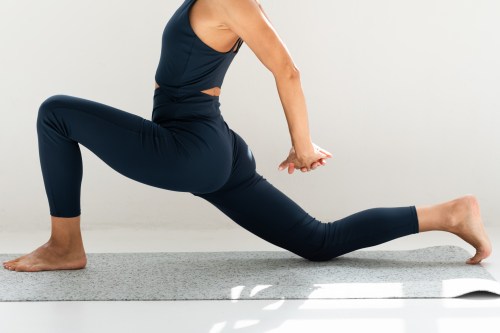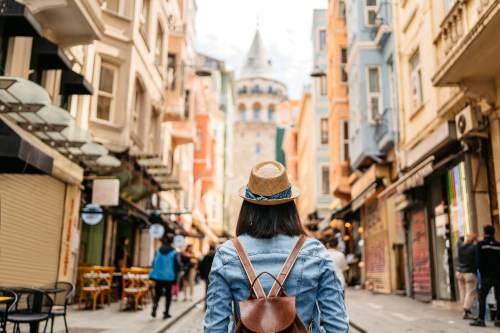Yoga has a long and rich history (like, thousands and thousands of years of history). As a result, the physical part of the practice, called “asana,” has evolved into countless traditions that range from restful to sweaty. That’s great news for you, because you’re pretty much guaranteed to find a style that fits you like a well-designed pair of leggings. If you start Googling around for a restful form of yoga that will help you get some R&R, you’ll likely find that yin yoga and restorative yoga come up again and again. But what’s the difference between the two? Below, Rachel Land, a Yoga Medicine therapeutic specialist with over 500 hours of yoga teacher training, talks restorative yoga versus yin yoga. Plus, how to choose the style that’s right for you.
Experts in This Article
yoga teacher, educator, teacher trainer, and writer based in Queenstown, New Zealand
“Yoga is rich tradition developed in India and other parts of South Asia, and the physical asana practice we are familiar with today is just a small part of it,” says Land. “One of the teachings of the yoga tradition is that we seek equanimity: a balance between ‘sthira and sukha,’ roughly translated as effort and ease.” Yin and restorative styles offer reflection and ‘sukha,’ but each style is unique. “Yin and restorative both sit toward the more restful end of the spectrum, helpful at times when we need to replenish our reserves and perhaps less so when our energy is high. However, they occupy different positions on that spectrum,” adds Land. Below, Land breaks down your FAQs surrounding these two chill yoga modalities. (So you can unroll your mat and start relaxing… stat.)
Restorative yoga versus yin yoga. First thing’s first: What is yin yoga?
According to Land, yin yoga is the perfect complement to the fiery “yang” energy you may get from other yoga practices like vinyasa or power yoga. “Yin yoga is characterized by passive, long-held, floor-based yoga poses that usually focus on the spine, hips, and legs. Infused with principles from Traditional Chinese Medicine (TCM), its title distinguishes it from more active and energetic ‘yang’ yoga asana practices,” she says.
Yin yoga poses are traditionally held for three to five minutes to get into the deep muscle tissue (or fascia) of the body that’s hard to access with brief bouts of stretching. “The aim of this practice is not to stretch these tissues, but to ‘stress’ them by offering gentle, sustained traction, compression, or shearing. That load seems to result in improved connective tissue hydration and collagen synthesis, both of which lead to increased strength and resilience,” adds Land. For example, you may lower into pigeon pose (eka pada rajakapotasana) and stay for three to five minutes to access the deepest recesses of the hips.
Although yin is a highly physical practice, it also benefits the mind. “Beyond the physical benefits of the practice, yin yoga can offer insight into the subtle body’s energy pathways or meridians. Given its emphasis on stillness, it can also allow students to decompress from the pace of modern life, and explore their capacity to sit with and examine sensation,” says Land. In fact, current research shows that myofascial interoceptors may stimulate areas of the brain where your emotions live. So don’t be surprised if you start crying in yin yoga… it happens to the best of us.
Cool. And what is restorative yoga?
“Restorative yoga aims to create deep mental and physical relaxation by down-regulating the nervous system,” says Land. In everyday life, we tend to rely on our sympathetic nervous system: our fight or flight setting that ups our alertness and prepares us to “fight” whatever comes at us. (Be it a bear or an hour-long Zoom meeting.)
Restorative yoga calms the nervous system and brings us back to our “rest and digest” state using long, passive yoga poses and oodles of props. “Restorative yoga has the capacity to offer wide-reaching physical and mental benefits, including impacts on heart rate, blood pressure, breath rate, digestion, resting muscle tension, mental state, fatigue, and even perceived pain,” Land explains.
At first glance, restorative may seem similar to yin—but the two are different. “Yin yoga usually involves some level of sensation in the targeted tissues: the region being stretched, twisted, or compressed. Even though props can be used to support the body, a significant part of the practice is learning to sit with that sensation and examine one’s responses to it,” says Land.
Restorative yoga, on the other hand, is designed to, well, swaddle you up like a baby so it’s really, really easy to relax and you’re exerting little to no effort. “Set-up can be intricate [in restorative yoga], involving multiple props arranged specifically to hold the body’s weight and off-load the joints, but the payoff is a much longer stay in each pose—anywhere from five to 20 minutes,” says Land.
One restorative asana is a basic child’s pose, or balasana, with your head stacked on blocks and a blanket between your hips and feet for extra support.
Give restorative yoga a try:
How to know if Yin yoga or restorative yoga is right for you
Now that you’ve familiarized yourself with these two “sukha’ styles of yoga, you’re ready to make your choice (or… you know, just do both)! If you still feel uncertain about which style will serve you best in this season of life, Land has a few tips for deciding. Since yin yoga is more physically and mentally demanding, it may be best for folks who are doing strenuous physical activity that needs to be balanced with deep stretching. However, there are caveats. “The sustained stress offered to our connective tissue also might not always be appropriate, for example during the early healing phase of soft tissue or joint injury or immediately before intense physical training,” she adds.
Restorative yoga, meanwhile, can be practiced regardless of what’s going on in your life. “Restorative yoga, in contrast, can offer support for those who feel completely depleted. Again with expert advice, it can often be practiced during exhaustion, illness, or injury, or as part of longer-term trauma treatment plans. However the lack of physical stimulation could actually have the opposite of its desired calming effect for students currently in the midst of high stress, trauma, grief, or anxiety,” she explains. So, okay, if you really need to just choose one, restorative yoga is more relaxing, but yin yoga is more stretchy for the body and mind—so take that as you will.
The TL;DR on restorative yoga versus yin yoga
To summarize here: Restorative and yin styles of yoga are great antidotes to busy, stressful lives. “To a casual observer, yin and restorative yoga look similar. Both emphasize the deliberate practice of stillness as a counterpoint to the activity of daily life. Both involve long-held, passive, floor-based poses sometimes utilizing the support of props like bolsters, blankets, blocks, and straps. In fact, many poses appear in both yoga styles. However the aim and internal experience of the two styles are completely different,” says Land. Yin invites you to wade deeper into your deep tissue fascia and unlock your emotions, while restorative yoga down-regulates your nervous system to deliver you to a state of rest and digest. There’s definitely room in your yoga practice for both, so try a class or two, experiment, and see which one helps you find that sense of calm you (so) deserve.
Oh hi! You look like someone who loves free workouts, discounts for cutting-edge wellness brands, and exclusive Well+Good content. Sign up for Well+, our online community of wellness insiders, and unlock your rewards instantly.
Sign Up for Our Daily Newsletter
Get all the latest in wellness, trends, food, fitness, beauty, and more delivered right to your inbox.
Got it, you've been added to our email list.











